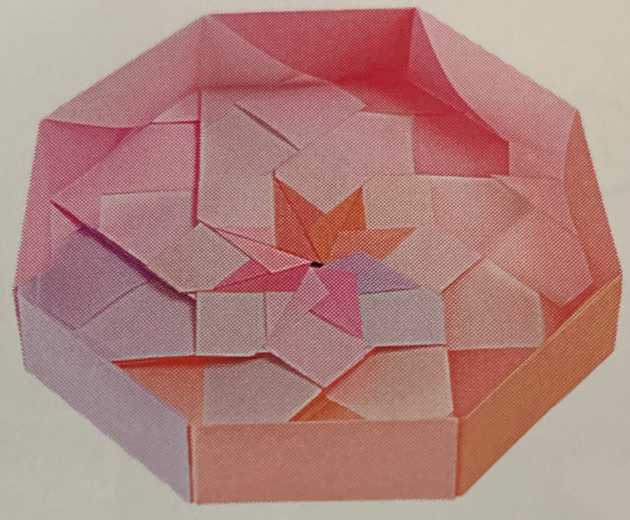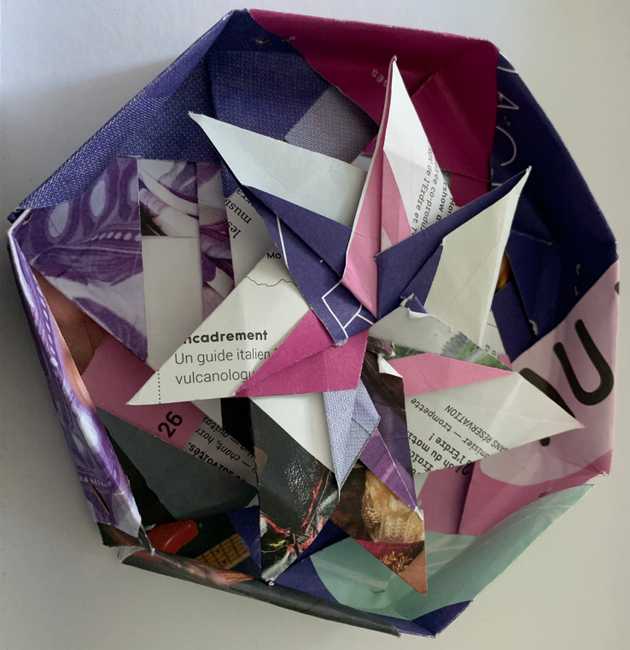Part 1: The complexity of folding a box, even for fun
In ancient times in Asia, paper was already expensive and used for utilitarian purposes (storage of foodstuffs, communication, etc.).
As you may know (for readers who know me personally), I love origami and especially utilitarian origami, a discipline aimed at producing paper figurines for everyday use. Boxes intended for food, bags of seeds for gardening or consumption, boxes, boxes and more boxes …
Practicing utilitarian origami these days is like stepping back in time. Above all, it allows the reuse of paper and offers a fun activity for young and old!
I have been experimenting with a variant of origami for several years: modular origami.
This is a particular technique, a specialization of traditional origami, by assembling without gluing figurines (which we will call modules) to obtain mainly boxes of different styles. I rely in particular on the teachings of Tomoko Fuse, an expert in the field.
It is indeed complex to make one of these figurines for a novice.
For a model of a complete octagonal box, for example, I need on average a little more than two hours *: 1h15 for the base, 1h15 for the cover made up of a total of 16 modules.
Here is the box in question:
I have a few dozen hours of modular origami practice. The precision to be achieved is of the order of a millimeter in the folds and the assembly for an acceptable realization (the appreciation is subjective in reality).
If we refine, for more than two hours of work I mean:
| N° | ENTITLED | DETAIL | APPROXIMATE TIME | DURATION RETAINED FOR A BOX |
|---|---|---|---|---|
| 1 | ARTISTIC CHOICES | the choice of paper (I only use magazines or expired brochures, varying from 70 to 90g / m2 of paper in an existing stock. | delay of around 30s for boxes cut from the same magazine | 8’ |
| 2 | MATERIAL PREPARATION | the cutting and the preparation of the paper, the choice of the format, the colors or the patterns which harmonize … according to each one in reality, it is the artistic side of the activity… | 1 to 2 ’per square. | 30’ |
| 3A | PRODUCTION | the folding of each of the 16 modules | 5´ per module or 5 * 16 = 80 ‘or 1h20 for the whole box. | 80’ |
| 3B | TOOLS | the realization of an optional template to individually control each of the modules | 5´ for the template, assimilated to a module, it is optional. | 5’ |
| 4 | ASSEMBLY | assembly of the modules (this is not the simplest of steps). Ah, I forgot to tell you, the instructions I have are in Japanese and I don’t understand written Japanese, just the visuals. The G ** trad service has always helped me with a diagram in my book. | 30’ per box, but it may take longer to understand the principle at the beginning. | 30’ |
| 5 | QUALITY | quality control, finish (sometimes the box cover does not fit with its base. | 1 to 2’ per box. | 2’ |
| 6 | MARKETING | (I leave the box lying around, if someone makes a good or bad comment elsewhere, it’s won). | negligible | 0 |
| TOTAL | 155’ that is 2h35’ |
I occasionally practice origami to relax. The loss rate is one in three boxes depending on my productions. The cost of the paper being what it is, it is the primary motivation for the choice of materials.
For the figure above, I spent 45 ‘for the base of the box, so I had to staple!
The reasons for this huge loss rate are multiple, they can be grouped into three main categories:
- the subject
- the environment
- the complexity of the assembly
The subject: the origamist
- dexterity, it varies between each folder.
- the level of experience of the folder in relation to the figure to be performed…
- the state of concentration of the folder at a time t.
- patience: the readiness of the folder to want to make a box in record time, by delusional skipping optional steps (mountain or valley fold for example, the knowledge of the basics of origami is essential). A channel that explains the basics well here.
The surrounding environment and the material
- the quality of the paper which varies according to what one uses.
- the humidity level of the paper, characteristic of the environment in which it was stored in my case a room at 18° with a humidity level of 60% on average.
- brightness (may result in loss of precision if insufficient for the folder).
The complexity
- The complexity of folding: you need rigor and rely on a precise diagram in a precise order.
- The complexity of the assembly: indeed, a badly operated assembly can degrade the quality of the modules and require a new assembly. Assuming that it is dedicated to this task, a folder with additional “spare parts” modules will therefore go faster in its assembly than a folder with the exact quantity so as not to slow it down if there are misfires.
- ….
Next time:
How does origami relate to industry, and more specifically to software industry?



